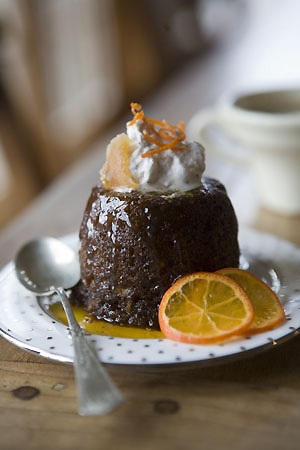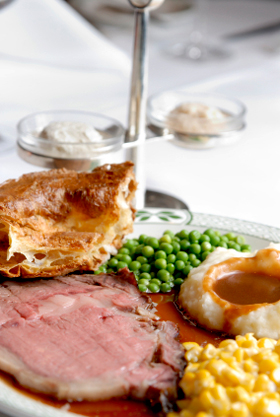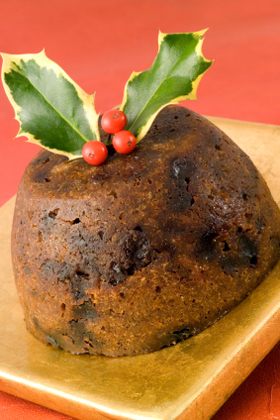 |

| |

Tasting even better than it looks, Sticky Ginger Pudding is perfect for the holidays—although we wouldn’t turn it away on a blazing August afternoon. Photo courtesy Sticky Toffee Pudding Company. |
| WHAT IT IS: Classic British puddings—moist cakes with sauces. |
| WHY IT’S DIFFERENT: Try to find something this meltingly good that you can serve warm from the microwave in 40 seconds. It’s better comfort food than a traditional cake. |
WHY WE LOVE IT: The individual servings are a divine treat, ready in 40 seconds. You can split one with someone you love; dinner parties couldn’t be easier (everyone can have his or her favorite flavor). Stick a candle on top for birthdays! |
| WHERE TO BUY IT: StickyToffeePuddingCompany.com and fine food stores nationwide (in the refrigerator case). See the store locator on the website. |
|
|
 |

The Sticky Toffee Pudding Co:
Tasty Pudding Society
CAPSULE REPORT: If you’ve just come back from long lines at the polls, you deserve a treat. We suggest everything made by The Sticky Toffee Pudding Company. Americans enjoy many blessings. One of them is that Englishwoman Tracy Claros moved to Texas and started a delightful specialty food company, making British-style puddings, which are like warm, individual cakes (learn more about puddings in the main review below).
Tracy makes four puddings: the classic British Sticky Toffee Pudding, which is one of those foods that, once tasted, becomes an instant favorite; Ginger Sticky Pudding, the Sticky for gingerbread lovers (and those who don’t yet know they love gingerbread); English Lemon Pudding (totally irresistible); and Molten Chocolate Baby-Cake, a chocolate lava cake that, excellent as it is, becomes the third runner-up in this cornucopia of riches, only because the other three are so seldom found that you must have them whenever you encounter them. We can’t name the winner—the three flavors tie for first place.
How wonderful is it to have before you a sumptuous dessert, about which even Gordon Ramsay could have no complaint? Simply remove the individual portion from the wrapper, place the cup in the microwave for 40 sections, invert the pudding and its sauce onto a plate and garnish at will. You may devour it in only slightly longer time than it took to warm. Or you may have more restraint than we do. No refrigeration is required, although refrigerating (or freezing) extends the shelf life. Read the full review below.
|
| |
|
|
THE NIBBLE does not sell the foods we review
or receive fees from manufacturers for recommending them.
Our recommendations are based purely on our opinion, after tasting thousands of products each year, that they represent the best in their respective categories. |
More Easy Desserts
 |
 |
 |
| Ice Cream Treats: Easy Ways to Transform Your Favorite Ice Cream into Spectacular Desserts, by Charity Ferreira. Even beginners can create delicious pies and tarts, using the four basic recipes upon which all other pies and tarts are based. Click here for more information or to purchase. |
Dessert Circus at Home: Fun, Fanciful, And Easy-To-Make Desserts, by Jacques Torres. Even if your pastry skills are elementary, Torres leads you through recipes step-by step. His mouth-watering recipes are certain to please. Click here for more information or to purchase. |
Easy Cakes, by Linda Collister. The Queen of Cakes provides the easiest recipes for the most delicious cakes you’ll ever taste, made with a hand-held beater. From layer cakes to pound cakes to tray cakes, you won’t know which to make first. Click here for more information or to purchase. |
The Sticky Toffee Pudding Co: Tasty Pudding Society
INDEX OF REVIEW
Click on the black links to visit other pages.
|
MORE TO DISCOVER
|
Introduction To English Puddings
Spend enough time in the U.K.—or take in enough books and films—and you’ll hear people asking for their after-dinner pudding. Is that rice pudding, tapioca pudding, banana pudding with Nilla wafers? No.
In many Commonwealth countries, a pudding most often refers to a sweet, cakelike dessert. These older-style puddings are baked, boiled or steamed. In the U.K., newer-style creamy puddings—those that Americans think of as puddings—are called custards if they are egg-thickened and blanc-mange, the French term, if they starch-thickened (these are our soft chocolate, vanilla and butterscotch puddings).
Yorkshire Pudding & Other Savory Puddings
But “pudding” can also be a savory dish—think of black pudding or blood pudding, a blood sausage; cheese pudding, similar to a cheese soufflé; corn pudding, a recipe with many variations, but one of our favorites is like a baked custard with corn kernels, cheese and herbs; kugel, a baked dish with many variations, including noodles, potatoes or cottage cheese; kishke, an Eastern European sausage or pudding; scrapple, a loaf of pork scraps and trimmings, sliced and fried; steak and kidney pudding (or pie), diced steak and beef, lamb or pig kidney, onions, and gravy baked in a suet pastry; and Yorkshire pudding (photo at right), a baked batter, among dozens of others. |
|

Roast beef with Yorkshire pudding. The pudding, at the top left of the plate, is made from batter and baked until it has risen. Photo by Atubo | IST. |
The Origin Of “Pudding”
The word “pudding” evolved from the French boudin (originally from the Latin botellus), meaning “small sausage.” In Medieval times, sausages were an ingredient in savory puddings. According to FoodTimeline.org, 17th century English puddings were either savory (meat-based) or sweet (made from flour, nuts and sugar), and were typically boiled in special pudding bags.
Far from the creamy dessert puddings popular in the U.S., these puddings were a solid mass formed by mixing various ingredients with a grain product or another binder (batter, blood, cereal, eggs, flour or suet, for example) and cooked by baking, boiling or steaming. The “pease porridge” of the old nursery rhyme was likely a simple boiled pudding made from pease meal. They were—and still are—served as a main dish; sweet puddings evolved and were served as dessert.
By the latter half of the 18th century, traditional English puddings no longer included meat. In the 19th century, the boiled pudding evolved into today’s cake-like concept, such as the Christmas pudding that remains popular. |
|

This cakelike Christmas pudding is steamed and
typically served with a hard sauce. Photo Mike
Bentley | IST. |
Continue To Page 2: Sticky Toffee Pudding Varieties
Go To Article Index Above
Do you have friends who would enjoy THE NIBBLE?
Click here to send them an invitation to sign up for their own copy. |
© Copyright 2004-2026 Lifestyle Direct, Inc. All rights
reserved. All information contained herein is subject to change at any time
without notice. All details must be directly confirmed with manufacturers, service
establishments and other third parties. The material in this e-zine may not
be reproduced, distributed, transmitted, cached, or otherwise used, except with
the prior written permission of Lifestyle Direct, Inc.
|
|




|
 |












